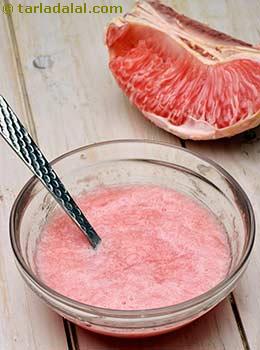grapefruit
Last Updated : Apr 10,2021
Grapefruit Glossary, Uses, Benefits, Recipes with Grapefruit
Viewed 52171 times
.jpg)
Also known as
Chakotra, Pamparamasu
Description of Grapefruit
Grown on a subtropical citrus tree, the grapefruit is a large fruit with a unique bitter taste. The outer skin of the fruit is yellow-orange while the pulp may be white, pink or red depending on the variety. The oblong fruit has a diameter ranging between 10 and 15 centimetres, while the flavour ranges from highly acidic and somewhat bitter to sweet and tart. This juicy fruit is hailed for its unique flavour and immense health benefits.
Chopped grapefruit
.jpg)
Place the grapefruit on a chopping board and use a sharp knife to chop the fruit with the skin into halves, quarters or even smaller chunks. The skin can then be peeled easily for each individual piece.
Grapefruit pulp

Chop the grapefruit into big pieces and blend it in a mixer till smooth.
Grapefruit segments

To get grapefruit segments, first peel the grapefruit by cutting a thin slice from both top and bottom. Then slice the peel and pith of the grapefruit starting from the top and moving your knife towards the bottom. Hold the fruit in one hand and cut along the inside of the membrane into the centre of the fruit to get V-shaped segments. Continue till you get all the segments from the grapefruit, and then discard the leftover middle membrane.
How to select Grapefruit
Choose grapefruits that are heavy for their size, as this means that they have thin skins and more flesh. Avoid those with overly rough or wrinkled skin as they are likely to be thick skinned. Go for fully-ripened grapefruit to get the most antioxidants.
Also remember that a good grapefruit doesn't have to be perfect in colour. Skin discoloration, scratches or scales may affect the appearance of a grapefruit, but they do not impact the taste or quality. However, if you see an overly soft spot at the stem end of the fruit and some areas of the fruit appear to be water-soaked, then it means the fruit is decaying. Such fruits will have a foul smell and poor flavour.
Culinary uses of Grapefruit
• Add a little sugar to the flesh of the grapefruit. Allow to soak for an hour or two and then enjoy it.
• Add grapefruit sections to salads for a tangy spark.
• Start your day with a glass of grapefruit juice.
• Combine chopped grapefruit with cilantro and chili peppers to make a unique salsa.
How to store Grapefruit
• Since grapefruits are juicier when they're slightly warm rather than cool, store them at room temperature if you are planning on consuming them within a week of purchase.
• If you will not be using them within this time period, store them in the refrigerator where they will keep fresh for two to three weeks.
Health benefits of Grapefruit
• Grapefruit is an excellent source of many nutrients and phytochemicals.
• It is a good source of vitamin C, pectin fibre and the pink and red hues contain the beneficial antioxidant lycopene.
• Studies have shown that grapefruit helps lower cholesterol and there is evidence that the seeds have high levels of antioxidant properties.
• It also eases constipation, as it causes loosening of the bowels and stimulates defecation.
• With its high fibre content and low glycemic load, grapefruit could work out in favour of weight-watchers.
Nutrition Information for Grapefruit
Nutritional Information for 1 no. of Grapefruit
One Citrus Fruit is 106 grams.
RDA stands for Recommended Daily Allowance.
47 Calories
1.06 grams of Protein
10.60 grams of Carbs
0.00 grams of Fat
33.07 mg Vitamin C = 82.67% of RDA (about 40 mg)
402.80 mcg of Vitamin A = 8.39% of RDA (about 4800 mcg)
13.78 mcg of Folic Acid = 6.89% of RDA (about 200 mcg)
0.12 mg of Vitamin B1, Thiamine = 9.23% of RDA (about 1.2 to 1.5 mg)
1.69 grams of Fibre = 6.76% of RDA (about 25 grams)
31.80 mg of Calcium (Ca) = 5.30% of RDA (about 600 mg)
31.80 mg of Phosphorus (P) = 5.30% of RDA (about 600 mg)
5.17 mcg of Vitamin K = 4.30% of RDA (about 120 mcg)
0.04 mg of Vitamin B6, Pyridoxine = 2.0% of RDA (about 2 mg)
9.54 mg of Magnesium (Mg) = 2.72% of RDA (about 350 mg)
0.30 mg of Vitamin B3, Niacin = 2.5% of RDA (about 12 mg)
0.21 mg of Iron (Fe) = 1.0% of RDA (about 21 mg)
0.02 mg of Vitamin B2, Riboflavin = 1.81% of RDA (about 1.1 mg)
0.21 mg Vitamin E = 1.05% of RDA (about 20 mg)
0.10 mg of Zinc (Zn) = 0.90% of RDA (about 10 to 12 mg)
1.12 mg of Sodium (Na) = 0.05% of RDA (about 1902 mg)
143.1 mg of Potassium (K) = 3.04% of RDA (about 4,700 mg)

Soya

Missed out on our mailers?
Our mailers are now online!
View Mailer Archive
Privacy Policy: We never give away your email
REGISTER NOW If you are a new user.
Or Sign In here, if you are an existing member.

If your Gmail or Facebook email id is registered with Tarladalal.com, the accounts will be merged. If the respective id is not registered, a new Tarladalal.com account will be created.
Hi,

Click OK to sign out from tarladalal.
For security reasons (specially on shared computers), proceed to Google and sign out from your Google account.